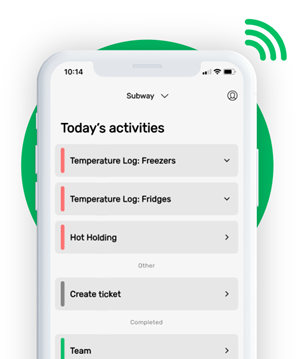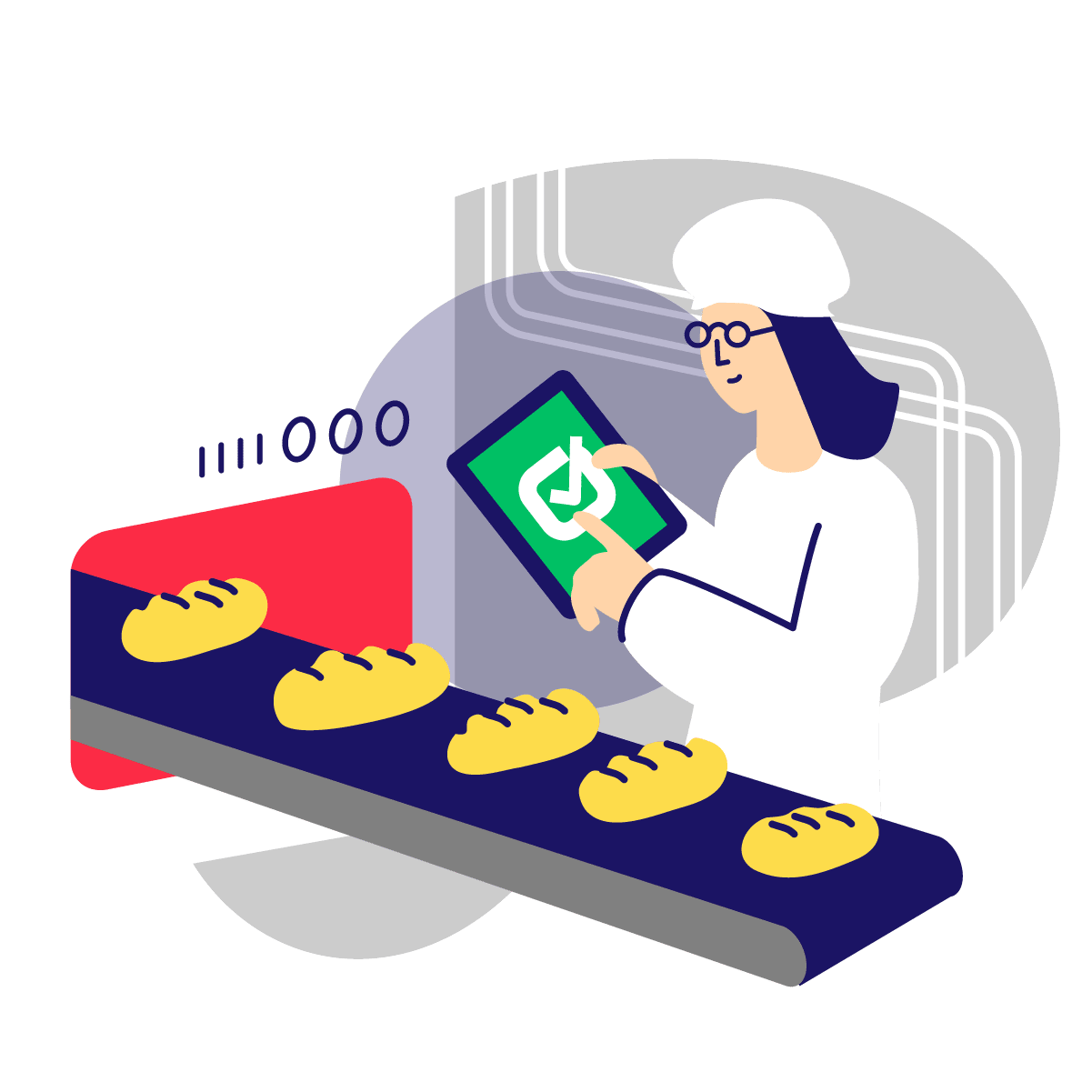OPENING A RESTAURANT CHECKLIST
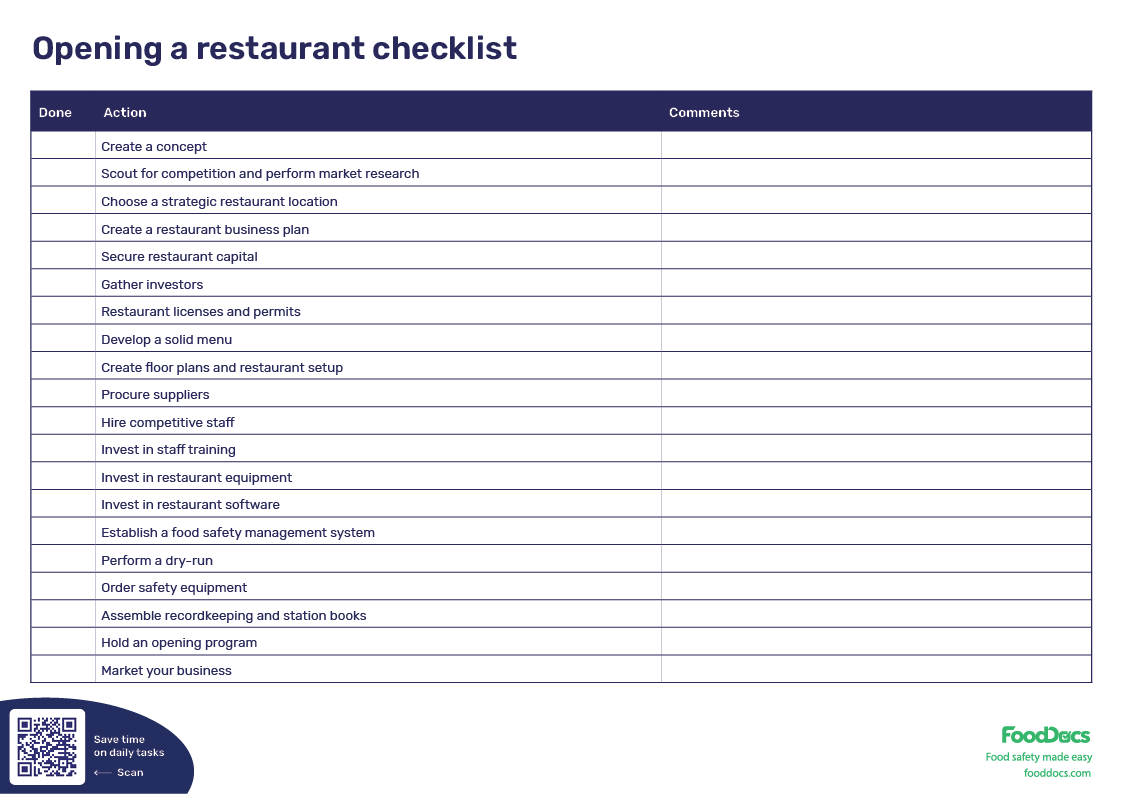

This is how our Digital Food Safety platform saves 20% of your time on daily tasks:
- Get upcoming task notifications
- Add data into the app
- Check the status of tasks in real-time

When food safety was still handled on paper, I typically spent a couple of hours per day getting the papers and going around checking or completing tasks… Now I can sit down and it's just all there in one place. It takes me 5-10 minutes.
Ruth B.
Store Manager
How to use the Opening a Restaurant Checklist?
Opening a restaurant is not an easy task. It involves several preparations to ensure that your business operations will be smooth while ensuring food safety and business efficiency.
To help you prepare, use our Opening a restaurant Checklist that includes all of the key tasks for this process:
- Familiarize yourself with the checklist. Check whether the pre-set information applies to the restaurant business you are planning to open.
- Add more rows or customize the checklist. If the pre-set values require changing, edit the information or add more rows to make the list more comprehensive.
- Download the checklist. Enter a valid email address and click on "Download."
- Use the checklist as a guide throughout the planning and opening stages.
Get more useful checklists from our free Food Safety Template hub.
Comply with the essential food safety requirements for opening a restaurant with the help of FoodDocs' smart Food Safety Management System with a built-in HACCP plan template software. Using our software, you can get automatically generated customizable monitoring tasks and smart tools.
Learn more about our software below.
From Concept to Grand Opening: Use an Opening a Restaurant Checklist
You may have dreamt of getting your restaurant at some point in a food lover's life. Who wouldn't want that? If cooking and serving delicious food are your passions, you could start any type of restaurant. Despite this, all aspiring food business owners must know that the National Restaurant Association has estimated that the restaurant industry has a 30% failure rate in the US restaurant industry alone. As such, it is important that you have to be prepared. Make sure you have everything ready before opening your restaurant. Use opening a restaurant checklist for this task.
Key points covered:
- Analysts have reported that at least 60% of restaurant ventures do not proceed past their first year, whereas 80% fail in five.
- Opening a restaurant requires effort and much planning.
- An Opening a restaurant Checklist is a helpful tool that includes the key steps to opening a successful restaurant.
- The cost needed to open a restaurant ranges from around $175,500 to $750,500.
- FoodDocs' smart Food Safety Management System can help restaurant owners establish a comprehensive food safety system in 15 minutes.
- Our software features customizable monitoring tasks, a smart notification system, and auditing tools that can help you maintain compliance.
- FoodDocs' smart Food Safety Management System has a built-in HACCP plan template builder that can generate a comprehensive HACCP plan for you within 1 hour.
WHAT WE'LL COVER:
What is an opening a restaurant checklist?
An opening a restaurant checklist is an essential tool that aspiring restaurateurs can use. The tool includes the most critical steps in building a food service business in order.
Our free opening a restaurant checklist includes steps for planning, food safety assurance, and legal and regulatory tasks.
This checklist is a starting point, and the specific tasks may vary depending on your restaurant's concept and location. Be sure to consult with industry experts, such as restaurant consultants or mentors, for guidance throughout the process.
What are the steps to opening a restaurant?
opening a restaurant requires a lot of back-and-forth planning. You have to consider every step that you will be taking carefully. As with any other task, having a clear and holistic view of what you are dealing with can significantly help you evaluate the task at hand. opening a restaurant means looking at it from the point of view of a restaurant manager, food safety manager, businessman, accountant, and city planner. Every little detail must be set to increase your chances of surviving in the industry.
We have taken the step of compiling all of the most important tasks that you need to do when opening a restaurant:
- Step 1. Create a concept
- Step 2. Scout for competition and perform market research
- Step 3. Choose a strategic restaurant location
- Step 4. Create a restaurant business plan
- Step 5. Secure restaurant capital
- Step 6. Gather investors
- Step 7. Restaurant licenses and permits
- Step 8. Develop a solid menu
- Step 9. Create floor plans and restaurant setup
- Step 10. Procure suppliers
- Step 11. Hire competitive staff
- Step 12. Invest in staff training
- Step 13. Invest in restaurant equipment
- Step 14. Invest in restaurant software
- Step 15. Establish a food safety management system
- Step 16. Perform a dry-run
- Step 17. Order safety equipment
- Step 18. Assemble recordkeeping and station books
- Step 19. Hold an opening program
- Step 20. Market your business
Step 1. Create a concept
The concept of your restaurant says a lot about how you want your business to be perceived by the customers. There are a wide variety of types of restaurants available in the market. Some of these include:
- Fast-food restaurants/ Quick-service restaurants
- Cafe
- Casual dining
- Fine-dining
- Ghost kitchens
- Family-style restaurants
- Food truck
Choosing the concept of your restaurant is the least worrying task and is a fun part of the process. There are hundreds of concepts to choose from. You want to properly portray your style of cooking, the ambiance you want to express, and the idea you want to be known for.
Do you prefer the outdoors and seeing different places while offering fast yet artisanal foods? Go and open up a food truck. If you prefer sit-down dining with a relaxing ambiance, formal furniture, and top-notch dishes, then opt for a fine-dining restaurant.
Think of the roots of why you want to open up your dream restaurant. In choosing your restaurant concept, you also have to consider the following aspects:
- Target customer
- Market share
- Specialty dishes
- Location
- Competition
- Current trends
Step 2. Scout for competition and perform market research
Performing market research is an essential step and must be included in a restaurant opening checklist. This restaurant operation includes considering your competition, the state of the market you will be entering, niche products, and potential gaps that you can fill with your restaurant. Market research can immediately prove to you if your concept will be a miss or a success.
A market analysis can also tell you whether your products will be received well by potential customers from your target market. Market research and industry analysis involve gathering information from the customers themselves. The results of your research can help you make better decisions.
Step 3. Choose a strategic restaurant location
The location of your business can determine how well you will do. Your accessibility to the target consumers will play a significant factor in creating a successful restaurant. If your location is too hard to reach, even your target consumers will try to locate an alternative restaurant.
If you want an upscale restaurant, you can choose to set up a business in a more industrialized location. On the other hand, if you plan to create a cafe, you would want a quiet and peaceful location. Your chosen location adds value to the services you offer. Customers pick their restaurants based on the location's food items, services, and ambiance.
Your chosen commercial space can also affect the labor cost. The cost of living in the area of your chosen location can determine the prices you will have to pay for goods and manpower.
Step 4. Create a restaurant business plan
Any pioneering business requires to have a strong business plan. Your business plan is the map and profile of your restaurant. It contains all of the general and specific plans you have and how you plan on achieving them. A business plan or business model should be a comprehensive document containing all of your strategies.
A business plan contains the following components:
- The goals and objectives of your restaurant
- Restaurant mission statement
- Company description and restaurant idea
- Management structure
- Manpower-related information
- Restaurant marketing plan and advertising strategies
- Operating cost
- Food safety plans
- Restaurant menu items
- Target potential investors
- Competitive analysis
- Financial projections
Your business plan must be professionally made with careful planning and well put to impress investors or the bank and show them how serious you are with your visions.
The plan you come up with may vary depending on the restaurant type you want to start.
Step 5. Secure restaurant capital
It goes without saying that putting up a restaurant requires a lot of money. This reason is why other aspiring restaurant owners prefer to launch a mobile food restaurant before starting a full-blown restaurant. Despite this, even a pop-up restaurant will require capital.
Not everyone is blessed with enough money to start a business and use the sole proprietorship strategy. Often, you would have to find investors or achieve partnerships. Additionally, you can apply for capital loans such as:
- Equipment loan
- Business loan
- Small Business Administration loan
- Merchant cash loan
- Business crowdfunding
There are many other kinds of restaurant loans, and every type will require you to have a solid business plan.
Step 6. Gather investors
Contrary to loans, seeking investors means finding a partner to fund your restaurant venture. Investors provide a portion of the capital you will need in return for owning some of the profit shares of your restaurant. Investors can be anyone you know who is willing to trust your restaurant or experts in the business who see potential in your plans.
Some types of investors for restaurant funding may include:
- Relatives - these investors can be anyone in your family who is willing to share your costs in building your restaurant. Most of the money they share either comes from trust funds or savings.
- Angel investors - wealthy individuals who invest in businesses even with high risks. Most angel investors are experts who have plans to participate in building your restaurant.
- Venture capital firms - this type of private investors bring in other advantages such as connections, business and food supplier recommendations, and others.
In selecting an investor, you must ensure that your ideas and objectives align. Agreements must be formed with everything on the table and with full disclosure.
Step 7. Restaurant licenses and permits
Licenses and permits are requirements to allow your business to operate in the restaurant industry. These documents are handed out to qualified businesses that have satisfied several inspections and other standards.
Here are some of the most important food service licenses and legal requirements when opening a food business:
- Registration for a business name
- License to operate/ Business license
- Foodservice license
- Employer Identification Number
- Food handler's permit
- Health permit
- Sanitary permit
- Liquor license
- Sales tax permit
Licenses vary in level based on food safety regulations. They can be federal, state, or local-level permits. Regardless of this fact, licenses are required and must be complied with before you can operate. Coordinate with food business agencies to guide you regarding these permits.
Secure your food safety and service license, health permit, and sanitary license from the health department by establishing a critical HACCP plan with our smart software. Using our built-in HACCPl plan template builder, you can get a comprehensive food safety plan designed specifically based on your operations. This solution can help you save significant time in preparing and revising your food safety plan.
Step 8. Develop a solid menu
For some, the concept comes first before a menu design, whereas for others, it's the other way around. The type of food you will be serving can depend on the type of restaurant you have. For food trucks, you want a short sample menu consisting of foods that can be prepared fast without compromising taste.
Building a menu does not only mean writing words on paper. Your restaurant menus will determine a lot of things such as the ingredients you will need, your food suppliers, the equipment you will use, the price of your services, food costs, and even the restaurant space and kitchen layout you need.
Step 9. Create floor plans and restaurant setup
The floor plan includes the placement of tables in your restaurant, the location of your kitchen, bathrooms, service area, counter, and food supply storage area.
The layout of your floor plan can be based on your budget, planned activities, operations, and your desired flow of food, restaurant workers, kitchen equipment, and customers. Consider making a floor plan that does not promote food safety hazards, attracts accidents, and has enough space for foot traffic.
Check out our detailed article about building a commercial kitchen layout.
Step 10. Create a list of credible suppliers
Your suppliers will provide the ingredients you will be using. This means that the quality of their raw materials will highly determine your food quality. In choosing any food supplier, make sure that you pick reputable ones with good track records. You can find these suppliers from recommendations or reviews.
Trusted suppliers also follow significant food safety laws. Screen your potential suppliers well by requiring a copy of their permits and licenses. Building a relationship with your suppliers can also bring your business benefits in the long run.
Step 11. Hire competitive staff
Your restaurant staff will be your frontline defense in the service. You will need servers, cooks, chefs, food safety managers, cleaners, and bookkeepers.
Competitive restaurant employees are a form of investment and key to a successful restaurant.
Bad customer service and performance from your chosen employees can cost you additional expenses or trouble in the future. This factor can significantly affect prospective customer satisfaction.
Step 12. Invest in staff training
You are also responsible for providing them with the necessary training, such as executing proper food safety practices. Training programs can be done before your grand opening to ensure that your employees are well-equipped.
In the case of a seasonal team, use proper training programs. Food handlers with very little knowledge of food safety operations have the potential to cause a foodborne scandal. An efficient and fast way to train seasonal employees is to use food safety restaurant training posters.
Step 13. Invest in restaurant equipment
A huge chunk of your capital will go into your equipment. If you know sources of second-hand or slightly used equipment, these will do at first. This way, you can save up or divert your money to buy other equipment. Just make sure that the kitchen equipment is working perfectly.
You can also opt to lease equipment if you are not 100% sure if you want it. Some companies allow equipment leasing for the long term.
Use a restaurant equipment checklist to identify which ones you already have and those that need to be prioritized.
Step 14. Invest in restaurant software
One of the steps to opening a restaurant can be investing in restaurant software. With the globalization of the food industry and advancements in technology, several restaurant software have already penetrated the market. Restaurant software is an online platform that can intuitively help automate your daily operations.
Some restaurant software can take over your accounting tasks, kitchen inventory management, reservation scheduling, a restaurant POS system, and even create comprehensive food safety management systems for you.
Step 15. Establish a food safety management system
Before you can even open your restaurant, most food safety agencies and the health department would require you to undergo a food safety audit. During this process, the safety of your facility, equipment, and daily practices will be evaluated by a health inspector.
To ensure that you will pass this type of audit, make sure to implement a comprehensive food safety management system that helps you monitor all food safety-related practices. Your approach to food safety shows your concern for your customers.
Establish your food safety management system in just 15 minutes using FoodDocs' smart software. Using our AI-powered software, you can get automatically generated monitoring logs and smart tools to ensure compliance with food safety standards and regulations.
Step 16. Perform a dry-run
A dry run does not have to mean a soft opening. This step guide can become your orientation process for all your employees before your opening day. Take this opportunity to polish any tasks that need revisited or operations that need more attention to improve customer experience.
Bring up the topic of using important food safety or restaurant opening checklists to make your workflow more efficient. Check out some of the most important checklists for a restaurant here.
Step 17. Order safety equipment
This step is for the safety of your employees and your customers. Invest in equipment such as safety gear, kitchen uniforms, wet floor signs, and padding for slippery floors. Additionally, choose to install surveillance cameras and smoke detectors for any unforeseen circumstances.
Step 18. Assemble recordkeeping and station books
Everything that happens in your restaurants, such as cashflows, number of customers, purchases, and food safety monitoring, must be neatly filed. These documents serve as proof and reference for future cases needing clarification. Additionally, this operation would be the best way to track the growth of your restaurant.
Store all food safety information in one cloud storage with FoodDocs' smart Food Safety Management System for traceability purposes. With our intuitive software, you can store and access all information with one central system and get smart tools for maintaining food safety compliance.
Step 19. Hold an opening program
Once you're all set with the abovementioned items, choose whether to do a grand opening or a soft opening. Your opening program will finally introduce your business to the world. Beforehand, you can spread the word as a marketing strategy to gather first-time customers.
During a soft opening, you can gather food critics or food bloggers to evaluate your food and operations. If everything goes well, your brand can skyrocket instantly.
Step 20. Market your business
Marketing can come before and after opening your restaurant. This operation is part of your marketing tactics to introduce your business to the community around you.
Marketing can be performed through traditional ways, such as prints and flyers, or through more advanced ways, such as social media, to gain a solid customer base.
Other marketing ways can be performed as targeted marketing, such as through email advertisements.
How much money should you save to open a restaurant?
A report by Restaurant Owner, which gathered information from startup businesses, emphasized that the cost of opening a restaurant can range from $175,500 to $750,500.
In another report, the average restaurant startup cost was estimated at around $275,000 and $425,000. These startup prices can inflate or deflate depending on several factors, such as location, concept, and equipment.
How can FoodDocs help you in opening a restaurant?
opening a restaurant at this time may mean that you have to consider embracing current restaurant trends. In this sense, we suggest considering using more technologically advanced systems such as POS and food safety management systems. These systems make work more efficient and accurate.
Your tasks do not end when you open up a restaurant. In fact, that is just the beginning. One of your biggest concerns will involve food safety. Keeping this aspect controlled can determine whether you will stay for long in the food industry or not. Your approach to food safety is one of the most important aspects of your operations.
To secure your business in terms of food safety, use FoodDocs' smart Food Safety Management System with a built-in HACCP plan builder.
- Customizable monitoring tasks for ensuring food safety compliance
- Smart notification system for reminding the team of critical monitoring tasks
- Food safety auditing tools for evaluating your business's preparedness
- Built-in HACCP plan template builder for complying with food safety requirements
Customizable monitoring tasks for ensuring food safety compliance
Get automatically generated monitoring tasks specifically based on your operations. Use these monitoring tasks and checklists to ensure that your business operates under the highest level of food safety standards.
Some of the customizable monitoring tasks you can get include the following:
- Cooking temperature log
- Freezer temperature log
- Master sanitation schedule
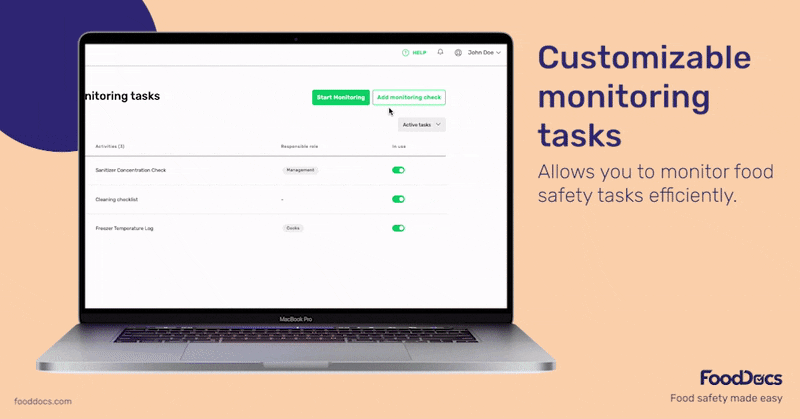
Customizable monitoring tasks from FoodDocs software
You can further improve each monitoring task by adding fields or parameters to check. Our team of experts ensures that your monitoring system will be customizable and fit the essential monitoring tasks unique to your operations.
Smart notification system for reminding the team of critical monitoring tasks
Pair each monitoring task with our smart notification system. With this feature, you can ensure that all critical monitoring tasks are done on time. Our system automatically alerts responsible food handlers, reminding them of a due task.
You can also use this feature to set a reminder for renewing licenses and permits. Enter the validity period of each permit, and our system will remind you to renew them on time.
Food safety auditing tools for evaluating your business's preparedness
Perform your business evaluations using our smart software. Use our food safety auditing tools to check if everything, both food safety-and business-wise, is set for your opening.
Create an auditing checklist from scratch to include all the necessary tasks for opening a restaurant and perform the evaluation through our free Food Safety App.
Use the information you gather to boost your preparations.
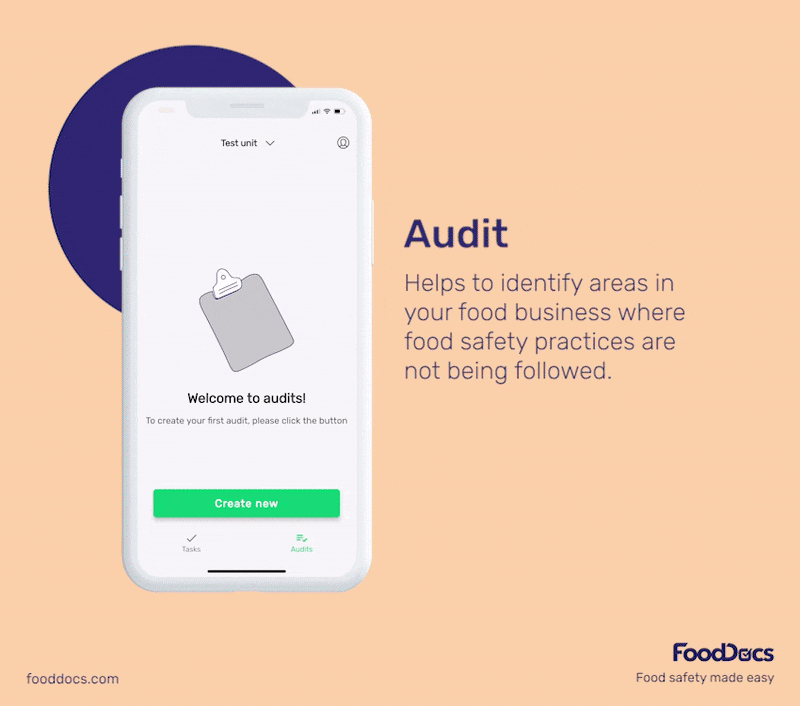
Food safety audit tools from FoodDocs software
Built-in HACCP plan builder for complying with food safety requirements
Imagine if you can get a comprehensive HACCP plan in just 1 hour. You would get an important document that needs several months to finish before a full-length movie even ends. The time you can save on making your HACCP plan means you get more time to prepare for other things. In just a matter of an hour, you can tick off tasks that require you to make a food safety plan and even comply with the license and permit requirements.
To get these tasks done fast, use our built-in HACCP plan builder. This software automatically builds a comprehensive HACCP plan in just 1 hour! Our system automatically generates this digital HACCP plan based on your answers to our basic questions about your food operations. This plan covers all of the most important areas of the HACCP system, from hazard identification to setting up a documentation process for your team.
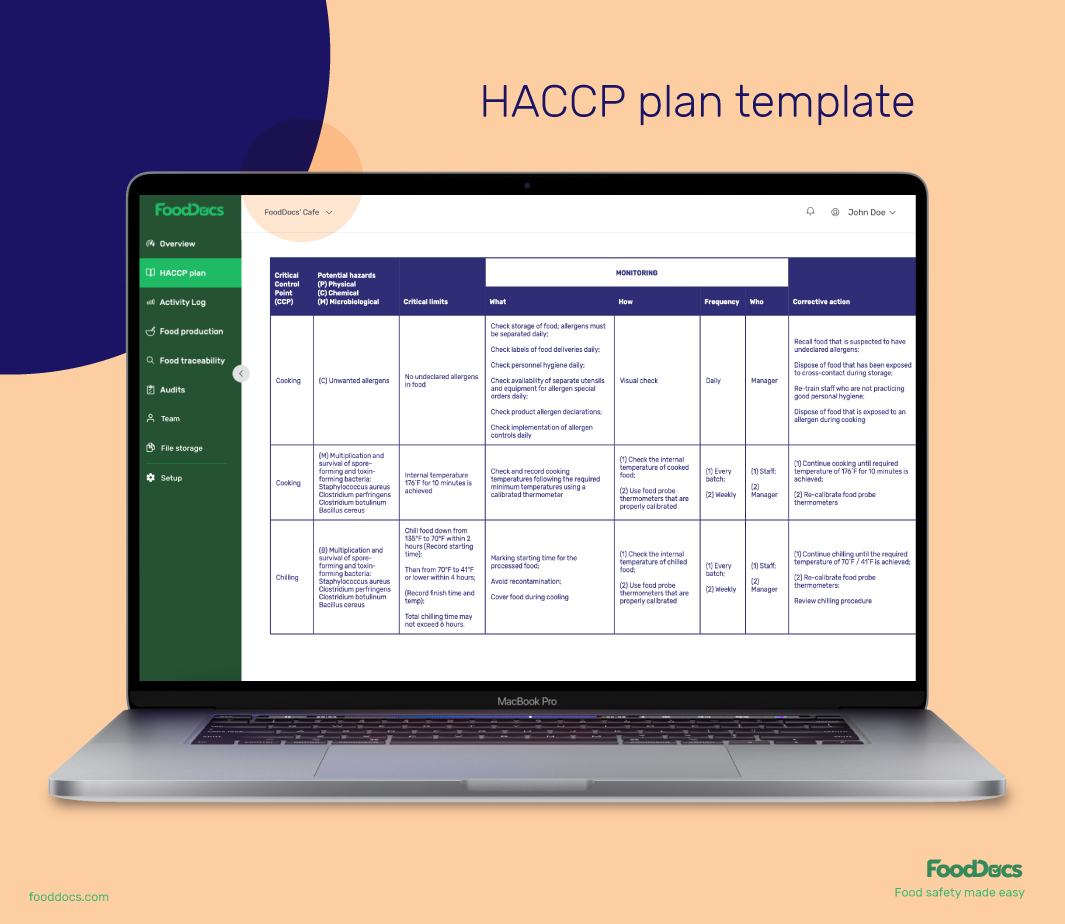
Haccp plan template from FoodDocs software
Let our software system at FoodDocs help you get compliant and maintain compliance throughout your operations in the food industry.
Book a demo with our specialists to understand how our smart software can help you build your restaurant business.
